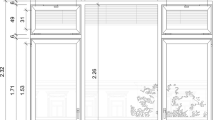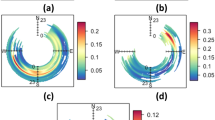Abstract
A pilot study was conducted using an occupied, single-family test house in Columbus, OH, to determine whether a script-based protocol could be used to obtain data useful in identifying the key factors affecting air-exchange rate (AER) and the relationship between indoor and outdoor concentrations of selected traffic-related air pollutants. The test script called for hourly changes to elements of the test house considered likely to influence air flow and AER, including the position (open or closed) of each window and door and the operation (on/off) of the furnace, air conditioner, and ceiling fans. The script was implemented over a 3-day period (January 30–February 1, 2002) during which technicians collected hourly-average data for AER, indoor, and outdoor air concentrations for six pollutants (benzene, formaldehyde (HCHO), polycyclic aromatic hydrocarbons (PAH), carbon monoxide (CO), nitric oxide (NO), and nitrogen oxides (NOx)), and selected meteorological variables. Consistent with expectations, AER tended to increase with the number of open exterior windows and doors. The 39 AER values measured during the study when all exterior doors and windows were closed varied from 0.36 to 2.29 h−1 with a geometric mean (GM) of 0.77 h−1 and a geometric standard deviation (GSD) of 1.435. The 27 AER values measured when at least one exterior door or window was opened varied from 0.50 to 15.8 h−1 with a GM of 1.98 h−1 and a GSD of 1.902. AER was also affected by temperature and wind speed, most noticeably when exterior windows and doors were closed. Results of a series of stepwise linear regression analyses suggest that (1) outdoor pollutant concentration and (2) indoor pollutant concentration during the preceding hour were the “variables of choice” for predicting indoor pollutant concentration in the test house under the conditions of this study. Depending on the pollutant and ventilation conditions, one or more of the following variables produced a small, but significant increase in the explained variance (R2-value) of the regression equations: AER, number and location of apertures, wind speed, air-conditioning operation, indoor temperature, outdoor temperature, and relative humidity. The indoor concentrations of CO, PAH, NO, and NOx were highly correlated with the corresponding outdoor concentrations. The indoor benzene concentrations showed only moderate correlation with outdoor benzene levels, possibly due to a weak indoor source. Indoor formaldehyde concentrations always exceeded outdoor levels, and the correlation between indoor and outdoor concentrations was not statistically significant, indicating the presence of a strong indoor source.
This is a preview of subscription content, access via your institution
Access options
Subscribe to this journal
Receive 6 print issues and online access
$259.00 per year
only $43.17 per issue
Buy this article
- Purchase on Springer Link
- Instant access to full article PDF
Prices may be subject to local taxes which are calculated during checkout



Similar content being viewed by others
References
Baek S.-O., Kim Y.-S., and Perry R . Indoor air quality in homes, offices, and restaurants in Korean urban areas — indoor/outdoor relationships. Atmosp Environ 1997: 31 (4): 529–544.
Brown V., and Crump D . The influence of indoor and outdoor sources on concentrations of benzene, toluene, and undecane in 173 UK homes. Proc Healthy Build 1995: 1: 385–392.
Clayton C.A., Pellizzari E.D., Whitmore R.W., Perritt R.L., et al. ECR 11 National Human Exposure Assessment Survey (NHEXAS): distributions and associations of lead, arsenic, and volatile organic compounds in EPA Region 5. J Expos Analysis Environ Epidemiol 1999: 9: 381–392.
Crump D.R., Squire R.W., and Yu C.W.F . Sources and concentration of formaldehyde and other volatile organic compounds in the indoor and outdoor air and the potential significance of inhalation as a human exposure pathway. Indoor Built Environ 1997: 6 (1): 45–55.
Edwards R., Jurvelin J., Koistinen K., Saarela K., et al. VOC source identification from personal and residential indoor, outdoor and workplace microenvironmental samples in EXPOLIS-Helsinki, Finland. Atmos Environ 2001: 35: 4829–4841.
Draper N.R., and Smith H . Applied Regression Analysis. John Wiley and Sons, New York, NY, 1981, p. 311.
Howard-Reed C., Wallace L., and Ott W . The effect of opening windows on air change rates in two homes. J Air Waste Manage Assoc 2002: 52: 147–159.
ICF Consulting and TRJ Environmental, Inc. Development of Microenvironmental Factors for the HAPEM4 in Support of the National Air Toxics Assessment (NATA). Prepared for the Office of Air Quality Planning and Standards, US Environmental Protection Agency, Research Triangle Park, NC, May 8, 2000.
Ilgen E., Levsen K., Angerer J., Schneider P., et al. Aromatic hydrocarbons in the atmospheric environment — Part II: univariate and multivariate analysis and case studies of indoor concentrations. Atmos Environ 2001: 35: 1253–1264.
Johnson T.R . Recent advances in the estimation of population exposure to mobile source pollutants. J Expos Anal Environ Epidemiol 1995: 5: 551–571.
Johnson T., Mihlan G., LaPointe J., Fletcher K., et al. Estimation of Carbon Monoxide Exposures and Associated Carboxyhemoglobin Levels for Residents of Denver and Los Angeles Using pNEM/CO (Version 2.1). US Environmental Protection Agency, Research Triangle Park, NC, 2000.
Johnson T., Weaver M., Mozier J., Kleindienst T., et al. Variation of residential air exchange rates under scripted ventilation conditions. Proceedings of the Specialty Conference for Measurement of Toxic and Related Air Pollutants, Air and Waste Management Association, Cary, NC, September 1–3, 1998.
Kelly T.J., and Fortune C.R . Continuous monitoring of gaseous formaldehyde using an improved fluorescence approach. Int J Environ Anal Chem 1994: 54: 249–263.
Kelly T.J., Smith D.L., and Satola J . Emission rates of formaldehyde from materials and consumer products found in California homes. Environ Sci Technol 1999: 33: 81–88.
Lee S.C., Li W.-M., and Ao C.-H . Investigation of indoor air quality at residential homes in Hong Kong — case study. Atmos Environ 2002: 36: 225–237.
Murray D.M., and Burmaster D.E . Residential air exchange rates in the United States: empirical and estimated parametric distributions by season and climatic region. Risk Anal 1985: 15: 459–465.
Otson R., and Fellin P . Volatile organics in the indoor environment: sources and occurrence. In: Nriagu J.O. (Ed.). Gaseous Pollutants: Characterization and Cycling, John Wiley and Sons, Inc., New York, 1992, pp. 335–421.
Ott W., Mage D., and Wallace L . Validation of the simulation of human activity and pollutant exposure (SHAPE) model using paired days from the Denver, Colorado, carbon monoxide field study. Atmos Environ 1988: 22: 2101–2113.
Pedditzi L., Kelly T.J., and Joseph D.W . Investigation of formaldehyde concentrations and sources in outdoor and indoor air using a new continuous monitor. Proceedings of the International Conference on Environmental Engineering — 99ICEE, Cartagena, Spain, September 9–10, 1999, published by the Universidad de Murcia, Servicio de Publicaciones, 1999, pp. 45–46.
Spicer C.W., Buxton B.E., Holdren M.W., Kelly T.J., et al. Variability and Source Attribution of Hazardous Urban Air Pollutants: Columbus Field Study. Report prepared under EPA Contract No. 68-D-80082. Battelle, Columbus, OH, May 1993.
Thomas K.W., et al. Temporal variability of benzene exposures for residents in several New Jersey homes with attached garages or tobacco smoke. J Expos Anal Environ Epidemiol 1993: 3 (1): 49–73.
US Environmental Protection Agency. (US EPA), 1991. Benzene exposure assessment model (BEAM), 3rd Report. Environmental Monitoring Systems Laboratory, US Environmental Protection Agency, Las Vegas, NV, EPA/600/X-91/091.
Wallace L., Emmerich S., and Howard-Reed C . Continuous measurements of air change rates in an occupied house for 1 year: the effect of temperature, wind, fans, and windows. J Expos Anal Environ Epidemiol 2002: 12: 296–306.
Wallace L., and Ott W . Air exchange rate experiments in a detached house using a continuous monitor. Presented at the 1996 Annual Meeting of the Society for Risk Analysis and the International Society of Exposure Analysis, New Orleans, LA, December 8–12, 1996.
Acknowledgements
Funding for this study was provided by the American Chemistry Council under the direction of Debra Philips and by the American Petroleum Institute under the direction of Kyle Isakower.
Author information
Authors and Affiliations
Corresponding author
Rights and permissions
About this article
Cite this article
Johnson, T., Myers, J., Kelly, T. et al. A pilot study using scripted ventilation conditions to identify key factors affecting indoor pollutant concentration and air exchange rate in a residence. J Expo Sci Environ Epidemiol 14, 1–22 (2004). https://doi.org/10.1038/sj.jea.7500294
Received:
Accepted:
Published:
Issue Date:
DOI: https://doi.org/10.1038/sj.jea.7500294
Keywords
This article is cited by
-
Association of Ventilation Rates with Building Design in Various Built Environments: A Critical Review
Current Pollution Reports (2023)
-
A simulation study of ventilation and indoor gaseous pollutant transport under different window/door opening behaviors
Building Simulation (2017)
-
Employing dynamical and chemical processes for contaminant mixtures outdoors to the indoor environment: The implications for total human exposure analysis and prevention
Journal of Exposure Science & Environmental Epidemiology (2006)



